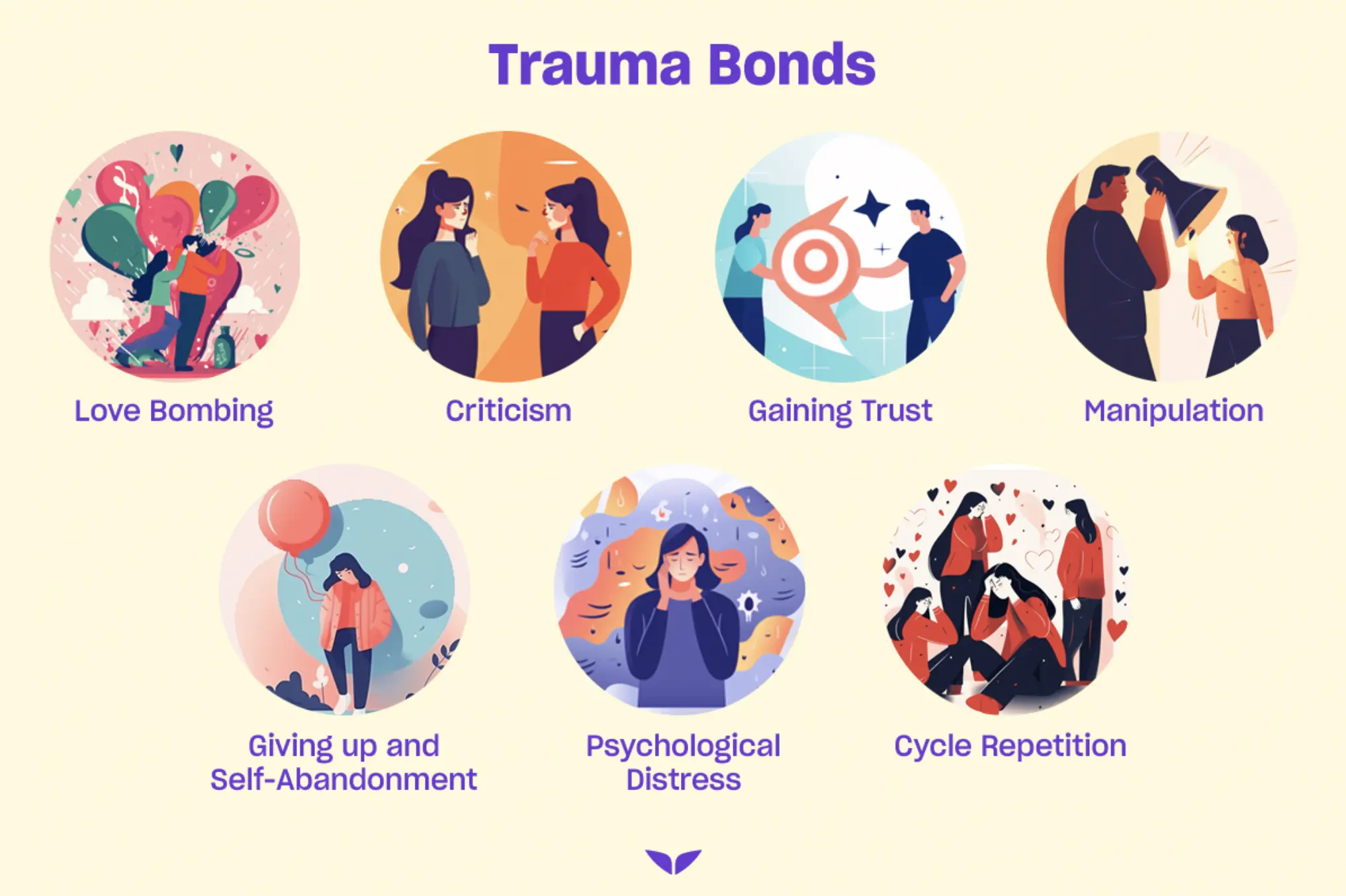Have you ever been in a relationship that felt like a rollercoaster ride? One moment you’re on top of the world, the next you’re plunged into despair. Or maybe you feel like you’re addicted to the drama or that you can’t leave because you’re too emotionally invested.
If this sounds familiar, you may be experiencing a trauma bond.
“All you need is love,” once sang The Beatles. But sometimes, love in a difficult relationship will deplete you of energy and, most probably, break your heart.
The good news is that you can heal from the patterns holding you back and create the healthy connections you deserve.
What is a trauma bond?
Trauma bonding is a powerful psychological phenomenon that can keep you trapped in a cycle of dysfunction and pain.
The term was first introduced by Dr. Patrick Carnes, founder of the International Institute for Trauma and Addiction Professionals. And he defined it as “dysfunctional attachments that occur in the presence of danger, shame, or exploitation.”
Trauma bonds may look like a complex emotional attachment that forms between two people in a relationship that involves abuse, manipulation, or (self) betrayal.
Studies show that trauma bonds can form in any type of relationship, whether it’s romantic, familial, or even between friends, but they’re most common within intimate connections. It can be caused by the reactivation of past patterns developed during traumatic experiences.
Dr. Carnes explains that even if the relationship hurts, the brain is seeking ways to create a survival mechanism, so it develops an unhealthy attachment, bonding with the subject that causes pain. It’s like being caught in a spider’s web: the more you struggle, the more trapped you become.
What’s more, a trauma bond may show similar characteristics to the spiritual concept of “karmic relationships.”
Examples
The trauma bond meaning is usually researched in more extreme cases, such as physically, emotionally, and mentally abusive relationships. One extreme example of such bonds is the abused victim developing empathetic feelings for the abuser, also known as Stockholm syndrome.
However, this kind of intense relationship may result from various forms of unhealthy attachment. For example, a person who experienced feelings of abandonment in early childhood may unconsciously choose partners that leave them constantly feeling lonely or unlovable.
Think of movie relationships such as Harley Quinn and The Joker or Netflix’s You. These examples show human connections built on toxicity, manipulation, and abusive behaviors.
Main signs and symptoms of a trauma bond
As mentioned, signs of a trauma bond can differ in gravity and intensity. However, here are a few of them that may signal red flags of a harmful relationship:
- Finding excuses for abusive behaviors
- Constantly believing that “they will change”
- Going through intense emotional highs and lows
- Finding it impossible to leave the relationship, although a part of you might want to
- Feeling shame and guilt around the relationship
- Constantly abandoning yourself in the relationship
It’s true that when you first fell in love with this person, you might have felt all rainbows and butterflies. After all, your body is releasing cortisol, the famous “stress hormone,” which can create a feeling of excitement and intensity.
But here’s the catch: that intense passion you feel in the beginning might actually be a sign that an old, traumatic pattern is being reactivated within you. In other words, your body may be reacting to something that’s already familiar to you rather than something new and healthy.
The 7 stages of a trauma bond
Each relationship is unique, but there may be a common pattern of the following stages in a relationship bonded by trauma:
- Love bombing. You’re overwhelmed with grand gestures from the other person, feeling that you’ve found true love, and it probably was at first sight.
- Gaining trust. The other person may show behaviors that make them seem trustworthy. However, when you doubt their actions, they might get extremely offended.
- Criticism. An on-and-off game of harsh accusations and over-apologizing starts taking place.
- Manipulation. It commonly takes the form of gaslighting and finding excuses for abusive behaviors.
- Giving up and self-abandonment. Also known as the “fawn response” to trauma, it involves using a people-pleasing behavior to avoid conflict.
- Psychological distress. Intense feelings of psychological distress are experienced during this stage. However, emotional numbness is also common, as are feelings of losing your sense of self.
- Cycle repetition. The trauma bond cycle tends to repeat itself once one of the people involved starts making promises that change will happen.
It’s essential to note that trauma bonding may be more or less intense, depending on the relationship. And even though there are ways to break the cycle and begin healing on your own, sometimes the fastest way to recover is to seek professional help.

How to break a trauma bond: 5 tips from Mindvalley experts
Besides having a strong support system and maybe engaging in a therapeutic process, there are a few things you can do for yourself when processing how to get over a trauma bond.
Here are a few tips from Mindvalley experts that may help you along your healing journey:
1. Let yourself feel | Katherine Woodward Thomas
When going through a breakup after an intense relationship, a lot of shame might rise to the surface, explains Katherine Woodward Thomas, relationship expert and trainer of Mindvalley’s Conscious Uncoupling Quest.
Shame that maybe you haven’t done enough to keep the relationship going. Or shame that you didn’t fulfill the “happily ever after myth” that runs through the veins of our society.
However, Katherine highlights the concept of “happily even after.” Happy that you learned valuable lessons that will empower your growth. And happy that you had the unshakable courage to let go of something that no longer fulfilled your needs.
In fact, psychology points out that celebrating going through hard times will paradoxically accelerate the whole healing process. For example, David Hawkins, a globally celebrated psychiatrist and founder of the Institute for Spiritual Research, has spent his life researching the effects of letting go of emotions without repressing or trying to change them in any way.
What he found was that once emotions are truly felt and let go, instead of running away and bottling them up, the process of healing occurs faster and somehow naturally.
2. Write a letter of forgiveness | Marie Diamond
Marie Diamond, renowned energy healer and trainer of Mindvalley’s Success Magic Quest shares a beautiful practice of forgiveness and releasing resentment that holds you back from moving forward: writing a forgiveness letter.
What’s important to keep in mind, she says, is knowing that the letter will be written to the soul of the person, not to their ego. So write down everything you wish you could have shared with them. Write about all the pain they caused and all the broken pieces of your heart you’re still trying to put back together.
You can write down all the hate, hurt, and frustration, but also the lessons you’ve learned about how to take better care of yourself on all levels.
When you’re done, Marie recommends signing the letter and burning it at noon on a sunny day. According to her, the reason for that is the high level of chi (life force energy) you have during that time of the day, resulting in a maximum capacity for letting go of resentment and moving on with your healing process.
3. Release trauma from your body | Jennifer Partridge
Research studies in the 21st century have found that trauma is stored in the body and can affect psychological health long after it occurs. And because of that, releasing somatic practices aids in healing and processing pain.
One gentle but powerful practice you can learn to do for yourself is EFT tapping therapy. And with the guidance and expertise of Jennifer Partridge, EFT practitioner and trainer of Mindvalley’s Tapping Into Emotional Mastery Quest, you may easily develop your own releasing routine.
The beauty of EFT is that it provides a safe space for emotional release while engaging in a light and non-intrusive process. And according to Jennifer, it prompts your life energy to flow freely through your body again, which allows you to access your natural state of self-love and empowerment.
4. Rewire your nervous system to live in the present moment | Juan Pablo Barahona
“Every layer of your being is in coherence with the full presence,” explains Juan Pablo Barahona, quantum flow teacher and trainer of Mindvalley’s Ultra Presence Quest. And learning how to embody full presence leads you to access the healing powers of your body, mind, and soul.
This may sound like an abstract concept that’s difficult to grasp, but it’s actually all about regulating your nervous system.
Studies show that regulating the nervous system helps people regain a sense of presence, calm, and safety after experiencing traumatic events.
Dr. Stephen Porges, the founder of the polyvagal theory, explains how your body’s sense of safety is regained by activating the parasympathetic nervous system. In turn, this helps create further secure connections and makes you feel more engaged in your life.
The magic of the nervous system, as JuanPa highlights in his Quest, means that you’re able to rewire old patterns and unhealthy beliefs that keep you unaware of the gifts that life has available to you. And you can do so through practices like:
- Quantum flow activation
- Yoga
- Breathwork
5. Fulfill the needs of your inner child | Dr. Shefali Tsabary
People often spend their entire lives uncovering and undoing the first seven years of their existence, as explained by Dr. Shefali Tsabary, clinical psychologist and trainer of Mindvalley’s Conscious Parenting Mastery Quest.
And so, developing unhealthy attachments and having your needs neglected as a child may turn out to be detrimental to your relationships’ security in adulthood. As mentioned, this can cause traumatizing bonds and toxic relational patterns later in life.
However, when you dive deeper into inner child work and learn how to fulfill the needs of that past hurt version of yourself, you may get a broader understanding of how your past influences your present.
“It is only through blinding and persistent awareness that we can begin to notice how we have been repeating patterns all our lives,” says Dr. Shefali. And once you spot your patterns, you can begin to rewire yourself and make conscious choices to create a life truly worth living.

Great change starts with healing
A healing process can sometimes seem daunting and never-ending. However, there’s infinite wisdom and possibility within yourself to break through hurtful patterns and rebuild your life, even from the ashes.
And a little guidance along the way might be just the extra support you need to speed up your process. If that’s what you’re looking for, Mindvalley is the place for you.
You can find transformational insights on your journey through powerful quests such as:
- Conscious Uncoupling with Katherine Woodward Thomas
- Success Magic with Marie Diamond
- Tapping Into Emotional Mastery with Jennifer Partridge
- Ultra Presence with Juan Pablo Barahona
- Conscious Parenting Mastery with Dr. Shefali Tsabary
By unlocking your free access, you can sample classes from these programs and many others and see how they impact your life.
And the best part of it all is that you don’t have to be alone on your path to transformation. You can join a community of like-minded people who are as eager to find the best version of themselves as you are. It’s in this togetherness that we may find healing and genuine connections.
Welcome in.










